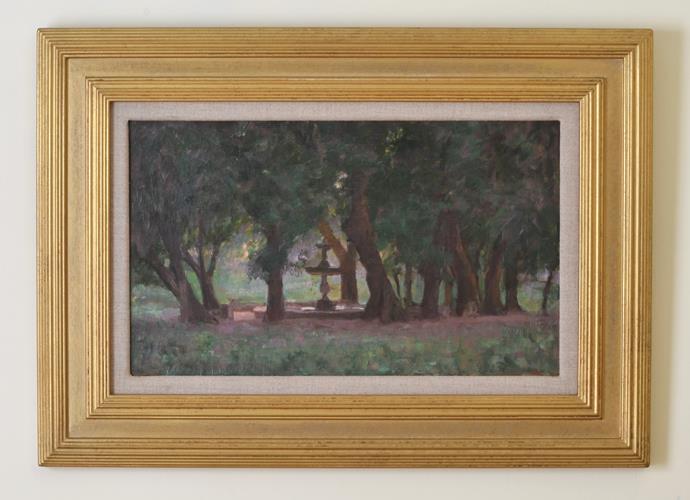Ilex Avenue, Borghese Gardens, Rome Arthur Studd
It is hard to be certain of the subject of this evocative picture. Yes, it is a glimpse of a stone fountain – quite an elaborate, tiered, one, designed to maximise the sounds of splashing water. It stands surrounded by the gloom of dark trees and shadows, each merging into the other. It seems quite possible that this was painted in the Gardens of the Villa Borghese, Rome. Begun on the Pincian Hill, above the hot heart of Rome (already known as ‘The Hill of Gardens’ in Ancient Rome), in the early 17th century for Cardinal Scipione Borghese, the extremely influential and wealthy nephew of Pope Paul V, replacing a vineyard and, in the 18th century, overlain with a landscape in the English style, the Borghese Gardens have welcomed visitors for over three centuries. In 1645, diarist, scholar and naturalist, John Evelyn, visited, admiring the groves and avenues. He set the tone for widespread acclaim for the Gardens which, in 1903 were bought by the commune of Rome and thereafter designated one of the largest public parks in the city.
I am persuaded that the painting introduces us to the ‘Ilex Avenue’ in the Borghese Gardens, which does, indeed, accommodate a fountain such as this – one of numerous fountains which fill the Gardens with the echoing plash of water. To an English mind, of course, an ‘Ilex Avenue’ suggests a planting of hollies. But that would be an error. The evergreen trees are the holm oak, Quercus ilex, native to Italy (and cultivated in the UK since the 16th century). This is, in fact, Italy’s national tree, symbolising strength and endurance, and is deeply rooted in the country’s cultural and historical fabric. With this in mind, the picture starts to reveal itself. The fountain - surely one of those introduced to the Gardens in the 17th century, before many of the formal features were replaced by an English landscape? - appears to be surrounded by a gathering of ancient, protective, trees. The trees are full of character, their sombre, animated forms permeated with their iconic fortitude and constancy. I do not know when Studd was working in Rome. But, this is a picture deeply imbued with the emotional intensity one finds in so many Whistler landscapes and we know that the latter loved and painted in Italy, especially Venice. Moreover, several galleries, including the Tate, have in their collections little landscapes of Venice, painted by Studd, which might even be mistaken for works by Whistler at first glance. We believe that Studd probably travelled quite extensively between 1903, after Whistler’s death, and 1908, certainly to Venice and, probably, to Rome – where the history, the romance and the captivating beauty of the Borghese Gardens would, surely, have appealed to Arthur Studd.
23.5cms x 39cms
40cms x 56cms

